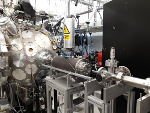| Version 10 (modified by , 7 years ago) ( diff ) |
|---|
LARA CDR Meeting 28th May 2019
Meeting details
Teleconference:
Phone details:
UK: 08082 380274 Austria: 0800 006612 PIN: 5904750902
Full list of telephone contacts may be found here.
Agenda:
- Introduction: KL
- Notes on last meeting and actions arising: All
- Last meeting 30Apr19. Few attendees. No notes posted.
- Conference contributions 2019:
- STFC opportunity call: All
- AoB
Notes:
Present:
Apologies:
- Introduction: KL
- Notes on last meeting and actions arising: All
- Last meeting 30Apr19. Few attendees. No notes posted.
- Conference contributions 2019:
- IPAC: CH, JPa,
- GSI: KL
- PTCOG: AK
- STFC opportunity call: All
- AoB
Summary of actions
Notes from IPAC19
by Christopher Hunt
Due to clashes, issues with the papers etc, I didn't manage to attend a lot in person, however these are some observations from what was available and a few conversation.
Found two of the biggest players, ELI and CLAPA (its likely that I missed some of the other big names). Both have similar ideas: laser-target produced protons with some conventional magnet based capture and delivery system, both targeting radiobiological research.
ELI:
- Prague institute
- Expect first beams by the end of the year
- They have designs for a cryogenic H2 target, basically extruding liquid hydrogen into the target area. It wasn't obvious how advanced the designs were
- Conventional focussing
- Use a reasonably big laser with plans to upgrade in the next few years (>1 Petawatt)
CLAPA:
- Peking University
- Publicized results already,
- Very large laser (I think Petawatt class), with planned upgrades
- Uses conventional focussing, maybe quadrupole capture,
- Claim very high stability and high energy beams
- Really seem like they are ahead in the game
Observed some comments on polarised beams to improve performance of laser-target interactions - not sure what the logic is?
General consensus is to just use a bigger laser and conventional capture/focussing. I got the impression that shop-bought petawatt-class laser was the starting point for several groups.
There were no mentions of high-current proton cyclotrons that I could find
I found one poster discussing a flash-dose electron cyclotron,
Found rapid-cycling synchrotron design with reasonable footprint (20mx10m) producing 250MeV beam. Due to the size of laser systems, this is probably the same footprint as a laser-target facility.
Couple of 200+MeV proton cyclotrons in the works, but these are low-current machines
